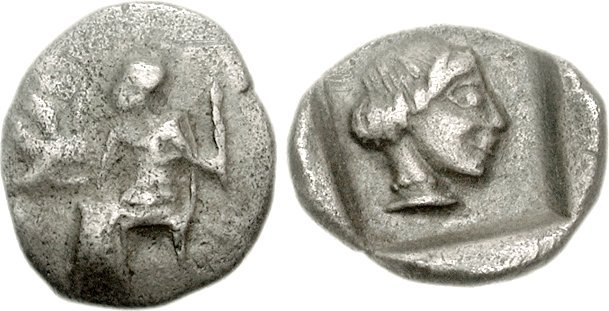AC 202 - Arcadia (Arcadian League), silver, obols (455-428 BCE)
From SILVER
455 BCE - 428 BCE Silver 920 kg
Description
| ObverseInscription or printing placed on the obverse.: | Zeus Lykaios seated left, holding scepter, eagle flying left from his hand. |
| ReverseInscription or printing placed on the reverse.: | Head of Kallisto right within incuse square. |
Mint and issuing power
| MintIdentifies the place of manufacture or issue of a numismatic object.: | Arcadia (various mints) | Ancient regionAncient region.: | Peloponnesus | Modern countryModern country: Greece | AuthorityIdentifies the issuing power. The authority can be "pretended" when the name or the portrait of X is on the coin but he/she was not the issuing power. It can also be "uncertain" when there is no mention of X on the coin but he/she was the issuing power according to the historical sources: | Arcadian league |
Chronology
| FromIdentifies the initial date in a range assigned in a numismatic context. | 455 BCE | toIdentifies the final date in a range assigned in a numismatic context.. | 428 BCE | PeriodTime period of the numismatic object.: Classical 480-323 BC |
Physical description
| MetalThe physical material (usually metal) from which an object is made.: | Silver |
Median weightMedian of the weights of numismatic objects (in grams). in grams | 0.80 | DenominationTerm indicating the value of a numismatic object. Examples: tetradrachm, chalkous, denarius.: | obol |
StandardStandard.: |
Image

AC202 Arkadia.jpeg [1]
References
| Die study referencePublication of the study: | Williams 19651Williams 1965, n° 141, 144-6, 153-4, 164-5, 173, 182-4, 190-5, 215, 226-7, 229, 267-74, 296-8 | ||
| Coin series referenceReference to coin series study: | HGC 52HGC 5, n° 923, RQEMAC3RQEMAC, n° 202 | ||
| Coin series web referenceCoin series web references: | |||
Obverse dies distribution
| FrequencyFrequency of specimen in distribution. ᵖ | Number of obversesNumber of obverse dies. ᵖ (o) | % (o) | Number of coinsNumber of coins. (n) | % (n) | Die nameName(s) of the die(s). |
| 1 | 16 | 51.61 | 16 | 29.09 | 68, 98, 99, 100, 107, 119, 125, 133, 144, 154, 179, 182, 184, 199, 200, 201 |
| 2 | 9 | 29.03 | 18 | 32.73 | 73, 95, 112, 113, 130, 134, 153, 156, 180 |
| 3 | 5 | 16.13 | 15 | 27.27 | 106, 131, 132, 181, 183 |
| 6 | 1 | 3.23 | 6 | 10.91 | 124 |
| Total | 31 of 31 | 100 | 55 of 55 | 100 |
Reverse dies distribution
no distribution is available
Quantification
| Number of obversesNumber of obverse dies. ᵖ (o) | 31 | Number of singletons (o1)The number of singleton coins. ᵖ | 16 |
| Number of reverse diesNumber of reverse dies. (r) | NC"NC" is not a number. | Number of coinsNumber of coins. (n) | 55 |
| Coins per obverse dieNumber of coins per obverse die. (n/o) | 1.77 | Coins per reverse dieNumber of coins per reverse die. (n/r) | |
| Reverse per obverse ratioRatio of obverse dies divided by reverse dies. (r/o) | Percentage of singletons (o1)number of coins (n) divided by the number of singletons (o1) ᵖ | 51.61 % | |
| Original number of dies (O) (Carter 1983 formula)The estimation of the number of coins according to Carter 1983 ᵖ | 57.48 | Coins struck if 20,000 as average productivity per dieCoins made if the average productivity for obverses (according to Carter) is 20,000. ᵖ | 1,149,600 |
| Original number of dies (O) (Esty 2011 formula)The estimation of the number of coins according to the singleton formula in Esty 2011 ᵖ (O) | 71.04 | Survival rate if 20,000 as average productivity per dieSurvival rate if average productivity is 20,000. ᵖ | 0.00005 |
| Coverage (o = % of O) (Esty 1984 formula)Esty 1984 - coverage (% of O) ᵖ (o = % of O) | 70.91% | Die productivity if survival rate 1/2,000Average productivity if survival rate is 1/2,000. ᵖ | 1,913.71 |
| Weight of silver (in kg) if 20,000 coins per die (O = Carter formula)Carter 1983 * Median weight * 20000 (*10 if gold or electrum) ᵖ | 920 kg <br /> 920 kg | Die productivity if survival rate 1/5,000Average productivity if survival rate is 1/5,000. ᵖ | 4,784.27 |
Remarks